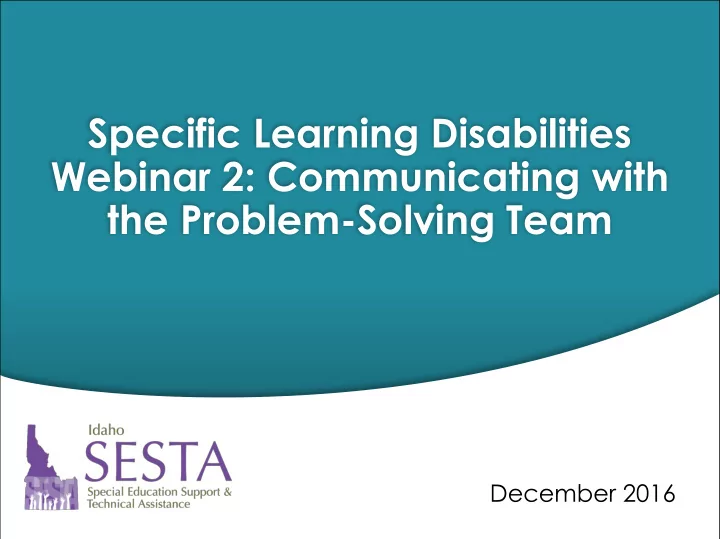

Specific Learning Disabilities Webinar 2: Communicating with the Problem-Solving Team December 2016
Objectives Increase your understanding of: l Importance of information provided by the Problem- Solving Team l Roles and responsibilities within the Problem - Solving and Evaluation Teams l Information used to determine whether or not a Referral for Special Education Evaluation is warranted 2
What is your team called? What name does your school or district use to identify the general education problem - solving team? • Problem - solving Team • Response to Intervention (RTI) Team • Multi - tiered System of Supports (MTSS) Team • Other 3
Intervention Information and Progress Monitoring Data 4
RTI Guidance 5
Response to Intervention l RTI is a general education tool that enables schools to target instructional interventions to children’s areas of specific need as soon as those needs become apparent. 6
Response to Intervention l RTI is the practice of matching and providing instruction and intervention, while systematically monitoring student progress to make decisions about the need for services. 7
Response to Intervention l All students included within this multi - tiered system of support . l Progress monitoring can also be used with students on IEPs to identify when a student has met benchmarks and/or identified goals, allowing for a flexible special education service delivery system. 8
Role of RTI within Evaluation l IDEA indicates that students must receive appropriate instruction in general education from qualified personnel before determining a student has a Specific Learning Disability (SLD). RTI practices focus on providing this instruction. l Data collected during the intervention period may be used as part of the evaluation. 9
Advantages l Earlier recognition of problems l All delays and/or deficits are treated under the same instructional model l Identification not necessary to provide additional support for the student l Differentiation and intensive instruction are provided to all students 10
Importance of RTI Information This information establishes the student’s current level of performance within the general education setting. 11
What do you use? What progress monitoring information does your Problem- Solving Team typically provide to you as part of referring a student for a Special Education Evaluation? • Aimsweb data • Data from EasyCBM • STAR Reading or Math Results • Other 12
Information from the Problem-Solving Team 13
Problem-Solving Team l Role of this team lies within general education and the RTI process l Matches interventions to the needs of students to ensure adequate progress is being made l Members could include teachers, administrators, counselors, instructional specialists and others 14
Evaluation Team l Role of this team is to make decisions regarding evaluation, assessment, and eligibility l Membership includes special education teacher(s), administrators, school psychologist, general education teacher(s), parent(s), and others as determined by the team 15
Intervention Information l The Evaluation Team might be provided with or request specific information from the Problem - Solving Team. This information will drive decisions made throughout the student’s comprehensive evaluation. 16
Intervention Information l Class assignments, grades, and work samples that demonstrate a weakness in the identified area(s) of concern l Notes, evidence, assurances, or documentation that core instruction is effective in the identified area(s) of weakness 17
Intervention Information l Documentation of parent input during the intervention period l Any additional information needed to provide a thorough background summary l Attendance records for the student 18
Intervention Information l Documentation of interventions, which includes start and end dates, frequency, and intensity of each intervention as well as decisions made throughout the intervention period l Progress monitoring data collected during interventions to include any graph or visual representation of progress made during the intervention period 19
Common Misconceptions l RTI interventions are a mandatory prerequisite to SLD Evaluation l Intervention programs must be implemented for the entire period of instruction l In tiered intervention models, all tiers must be completed prior to referral 20
OSEP Memorandum 21
Something to Consider l Avoid unilateral decisions on general education interventions which include: - decisions on timelines for interventions; - choice of available interventions ; - schedules for progress monitoring; and/or - a point at which to initiate a referral to consider an evaluation. 22
How is information provided? How does your Problem - Solving Team provide information to the Evaluation Team at your school or district? - Mileposts - Google forms - File folder of information passed from one team to another - Other 23
Referral to Evaluate for Special Education 24
Example l Student: Ben Ortiz l Grade: Third l Area of Concern: Basic Reading Skills l Intervention Period: 9/16 – 1/17 25
Referral l A referral to consider a special education evaluation is sent to the evaluation team after the problem - solving team has determined: - The student has not made adequate progress - Language and/or culture differences are not the main source of the student’s struggles 26
Referral Moving from general to special education l The Evaluation Team, including the parent(s), reviews all available records. l The Evaluation Team determines whether or not an evaluation is warranted 27
Example 28
Review l Intervention and progress- monitoring data l Information from the problem - solving team l Referral to evaluation for special education 29
Next Steps l If you are taking this course for credit: - Complete the quiz with a passing grade (70% or better) prior to the next webinar l Attend Webinar 3 on 1 - 19 - 17at 4:00 MT/ 3:00 PT - Before this webinar, read Chapter 4, Section 5C (pg. 43 - 44) of the Idaho Special Education Manual 30
Cathy Thornton Associate Director Nichole Kristensen Instructional Coordinator Dawn Spurlock Instructional Coordinator Alayna Gee Multi-Tiered Systems of Support Coordinator www.IdahoSESTA.org
SUPPORTING SCHOOLS AND STUDENTS TO ACHIEVE SHERRI YBARRA, SUPERINTENDENT OF PUBLIC INSTRUCTION
Recommend
More recommend